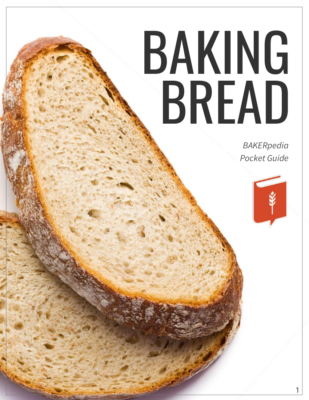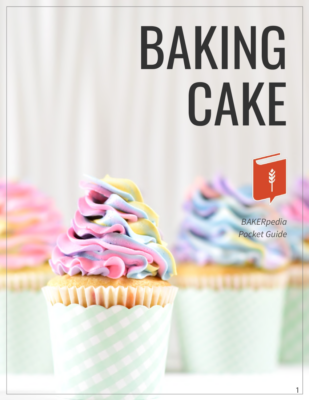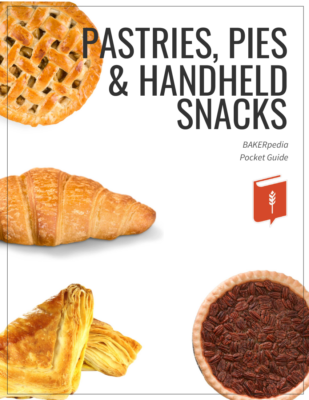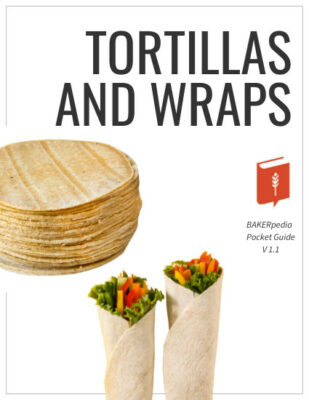Baking Specialties
Bread is a combination of flour and water that has been baked. Over the years bread production has become increasingly more complex with a multitude of additions ranging from fruit to nuts, and many different kinds of flours. Bread is a staple food in many countries and has cultural significance as well. With common sayings arising such as “the bread winner,” bread has become one of the most important parts of the worlds diet. Download our Baking Bread Pocket Guide to learn more!
Cake is obtained from a chemically leavened batter that results in a spongy and airy texture. There are thousands of cake recipes and variations, but there are some consistencies in defining cake. Cakes are typically circle in shape, however many cakes are also rectangular, or cut into specific shapes in order to be decorated. Cake is almost always sweet, which differentiates cake products from bread, which is typically not sweet. Additionally, cake is often made from a batter, which is much more liquid than dough. Cakes are often named based on their primary ingredients, such as butter cakes, or their shapes, such as Bundt cakes and layer cakes. Download our Baking Cake Pocket Guide to learn more!
Doughnuts are a fried dough confectionary often eaten for breakfast or as a dessert. This sweet comfort food first appeared in cookbooks in 1803, and was officially termed “dough nut” in 1809. By 1900, doughnuts were being referred to as the more common “donut” in the United States because donut is an easier spelling and ease of pronunciation for immigrants. Download our Baking Donuts Pocket Guide to learn more!
The gluten free market is a key space for consumers and bakers. Now that it’s a well established trend, there’s improved ingredient technology making it easier to achieve quality taste, texture and shelf life. Avoiding the usage of wheat or any other gluten-containing grains can result in a gluten-free product. These products are the only consumable bakery products for consumers with gluten allergies, gluten intolerance and celiac disease. Download our Baking Gluten-Free Pocket Guide to learn more!
The keto (or ketogenic) diet is a fast-growing weight loss dietary trend that is raising the demand for nutritional-packed baked goods. Keto-friendly goods should be low-carb, high-protein, and high-fiber. This kind of baking demands the use of alternative ingredients and processing methods. The corresponding baked goods, therefore, are quite different from standard wheat flour-based bakery products in both taste and appearance. Download our Baking Keto Pocket Guide to learn more!
The term pastry primarily refers to either savory or sweet products wrapped in some form of pastry dough. There are many forms of pastry dough, though the most common is short crust pastry dough. The basic ingredients of pastry dough are flour, sugar, milk, shortening, baking powder, and eggs. When these ingredients are combined to form a dough that is flakier or crumblier than bread dough. The high fat content in pastry dough, and how the fat covers the flour used is what leads to a flakey pastry. Presentation is also more highly valued in pastries, therefore there is typically more time spent on making this product. This leads to a more expensive product. Pies also use pastry dough and are filled with sweet or savory fillings. Pies can either be baked or fried. Download our Pastries, Pies, and Handheld Snacks Pocket Guide to learn more!
Pizza is a savory dish made with a form of flatbread and usually topped with tomato sauce and cheese. The word “pizza” is thought to have come from the Latin word pinsa, meaning flatbread. It is thought that the Italians invented Pizza. However, its origin goes back to ancient times in the Middle East. Download our Baking Pizza and Flatbread Pocket Guide to learn more!
Tortillas are flat, thin, light-colored, round breads, made from corn or wheat. Depending on the region, they may vary in size from 6-30 cm. Along with tacos, burritos and enchiladas, tortillas are considered a staple food for most people in Mexico and Central America. In the U.S., wheat flour tortillas are the fastest growing segment of the entire baking industry. Flour tortillas are a favorite of NASA astronauts and have been on their space menus since 1985 due to their ability to handle microgravity problems, unlike bread crumb. Download our Tortillas and Wraps Pocket Guide to learn more!
Crackers, or savory biscuits, are a savory and crunchy product made by layering sheets of strong dough and baking until the texture is crunchy. Crackers come in a variety of shapes, sizes, colors, and flavors, but are generally three inches or less in diameter, 1-5% moisture, and made from grain flours. Crackers by definition are 60% flour, which is higher than most other baked products. The low moisture content of crackers leads to longer shelf life than other baked goods. Crackers that are high in sugar typically form weak dough; therefore most crackers have a low sugar content. Crackers also always have small holes called docking holes cut into them in order to prevent large pockets of air from forming in the product.
A cookie is usually a small sweet, crispy or cake like pastry made often with flour, sugar, liquid and fat. It’s name is derived from the Dutch word Koekje, meaning “small or little cake”. The earliest cookie dates as far back as 7th century A.D. in Persia, where they first cultivated sugar. In England and the British colonies, cookies are also called Biscuits. The Germans call them Keks, or Plätzchen, and the Spainards call them Galletas. In Italy, there are several forms of cookies including amaretti and biscotti.









